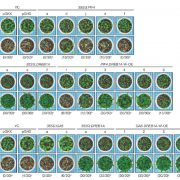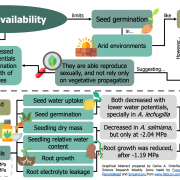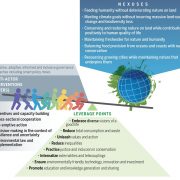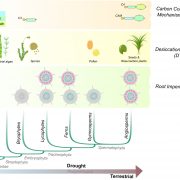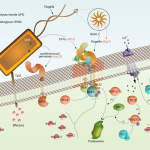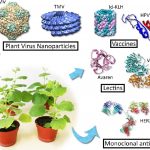Review: Molecular bases of responses to abiotic stress in trees (J. Exp. Bot)
 Much of our understanding of abiotic stress response comes from studies on short-lived annual plants, for good reasons: they are small and easy to study, their short-generation time makes them amenable to genetic studies, and most of our food comes from annual plants. Trees are more difficult to study, but no less important in their roles as ecosystem service providers, sources of wood and fibers, and major global carbon sinks. As large, long-lived organisms, trees face additional abiotic challenges, such as long-distance water transport and coping with widely varying seasonal temperatures. Worryingly, trees are already showing their vulnerability to climate change. Estravis-Barcala et al. look the molecular bases of tree responses to abiotic stress, including short-term acclimation responses and longer-term adaptation responses, pulling together new studies from a range of tree species. They also summarize efforts to identify the genetic basis for adaptation to local environments through genome scanning and the identification of selection signatures, which have pinpointed selected dehydrins and histones as contributors. The review also usefully highlights some of the key knowledge gaps that remain to be addressed. (Summary by Mary Williams) J. Exp. Bot. 10.1093/jxb/erz532
Much of our understanding of abiotic stress response comes from studies on short-lived annual plants, for good reasons: they are small and easy to study, their short-generation time makes them amenable to genetic studies, and most of our food comes from annual plants. Trees are more difficult to study, but no less important in their roles as ecosystem service providers, sources of wood and fibers, and major global carbon sinks. As large, long-lived organisms, trees face additional abiotic challenges, such as long-distance water transport and coping with widely varying seasonal temperatures. Worryingly, trees are already showing their vulnerability to climate change. Estravis-Barcala et al. look the molecular bases of tree responses to abiotic stress, including short-term acclimation responses and longer-term adaptation responses, pulling together new studies from a range of tree species. They also summarize efforts to identify the genetic basis for adaptation to local environments through genome scanning and the identification of selection signatures, which have pinpointed selected dehydrins and histones as contributors. The review also usefully highlights some of the key knowledge gaps that remain to be addressed. (Summary by Mary Williams) J. Exp. Bot. 10.1093/jxb/erz532



